Santoku vs. Chef’s Knife: 5 Key Differences
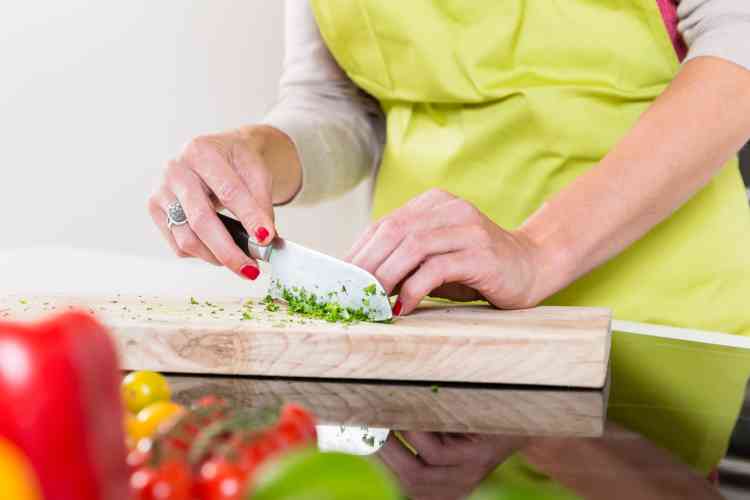
Are you debating between a santoku vs. a chef's knife to update your kitchen cutlery collection? Experimenting with different types of cutting tools is an excellent way to take your skills to the next level. Maybe you’re wondering what the difference is between a santoku vs. chef's knife?
Both a santoku and a chef’s knife are general-purpose cutting tools found in professional and home kitchens. When comparing a santoku vs. chef's knife, they’re equally adept at slicing, dicing and mincing a variety of fruit, vegetables and meat. However, there are a few differences that might make one a better choice depending on what you’re preparing. Keep reading to discover the difference between a santoku vs. chef's knife.
Jump to Section
What Is a Santoku?
A santoku knife is a Japanese-designed kitchen cutting tool. The word santoku means “three uses.” This refers to the three types of food it’s designed for (meat, fish and vegetables) as well as for the three knife cuts of slicing, chopping and mincing.
Santoku knives generally have a pointed tip, a straight-edge blade and a traditional D-shaped handle. They have a gently curved spine that comes down to a pointed tip, and there are usually indentations on the blade that prevent food from sticking to it. Santoku knives and other Japanese knife types are designed for a single downward cut, a traditional Japanese culinary technique.
Use the santoku knife for a wide variety of tasks such as slicing vegetables, fish and beef or mincing and dicing herbs, garlic, onions and carrots. Santoku knives are excellent for chopping potatoes, apples and tough root vegetables.
Some santokus have a Western handle to complement their Japanese blade. The Kikuichi Elite Warikomi Damascus Tsuchime 7" Santoku Knife is one such santoku, making it one of the best types of kitchen knives for balance, durability and precise cutting performance.
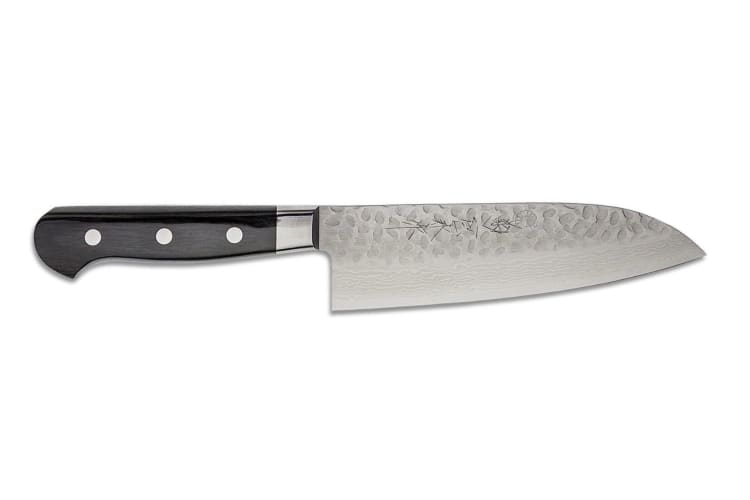
For a more traditional design, the versatility of the Miyabi Black 7-Inch Rocking Santoku Knife and the tsuchime (“hammered”) finish of the Miyabi Birchwood SG2 7-Inch Santoku Knife makes either one the best santoku knife for mincing garlic cloves, slicing tuna or cutting blocks of cheddar.
What Is a Chef’s Knife?
Originating in Germany, the chef’s knife is a versatile, durable and ergonomic kitchen cutting tool that offers a diverse range of uses. It’s adept at cutting, slicing and dicing everything from fish, chicken and beef to fruit, vegetables and herbs.
When comparing a santoku vs. chef's knife, the chef’s knife generally has a straight spine that comes to a pointed tip. A chef’s knife has a large and thick bolster — a space between the blade and the handle — for safety while using the pinch-grip cutting technique. It features a smooth blade surface that delivers smooth cuts and slices. Chef’s knives can have a curved or straight blade edge and a large belly. The handles are usually ergonomically shaped for comfort and hand fatigue prevention.
Use the chef’s knife for complex cuts such as disjointing meat and separating chicken parts, as well as traditional techniques like mincing and dicing vegetables or slicing cheese.
The large bolster and razor-sharp point on the Miyabi Birchwood SG2 6-Inch Chef’s Knife (shown below) make it one of the best kitchen knives for home or professional chefs.
With a large belly, ergonomic handle and full tang construction, the Zwilling Pro Chef's Knife and the Steelport 8-Inch Carbon Steel chef's knife are both one of the best chef's knives for slicing fish, mincing herbs and garlic or dicing carrots.
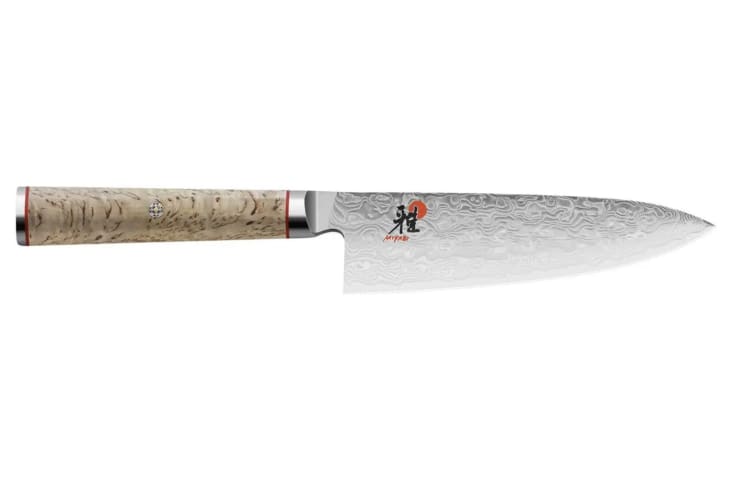
Santoku vs. Chef’s Knife: 5 Key Differences
1. Origin
One of the main differences in a santoku vs. chef's knife is where they come from. The santoku knife originated in Japan. The chef’s knife originated in Germany even though it’s often simply referred to as a “Western knife.” Both countries were known for sword-making and metal fabrication, so it only made sense to make the transition from warfare to kitchen cutlery.
Wüsthof and Zwilling J.A. Henckels are popular German brands. Kikuichi and Takamura are Japanese brands. Then there’s Miyabi, which — as our Miyabi knives review explains — is actually owned by Zwilling J.A. Henckels. Miyabi blends German technology and Japanese knife-making techniques to create a hybrid cutting tool with the best of both worlds.
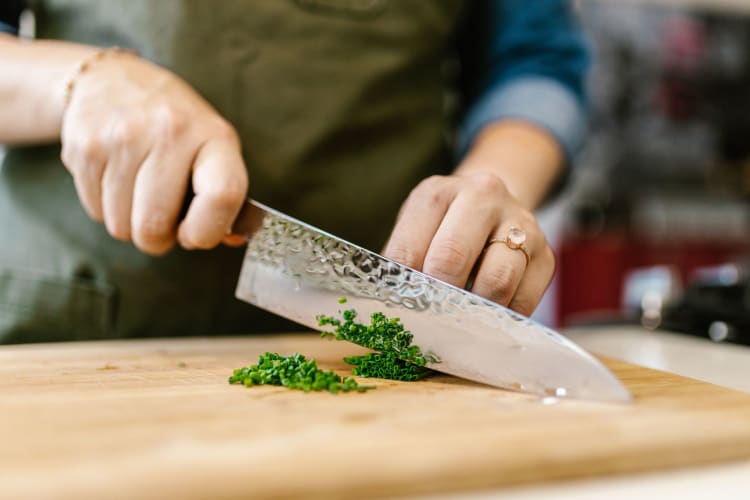
2. Blade
Edge and Shape
Another key difference between a santoku vs. a chef's knife is the cutting edge and blade shape. A santoku has a shorter, wider and flatter blade than a chef’s knife. This wide blade can be used to “scoop” food while transferring it from the cutting board to a cooking vessel.
Finish
When it comes to preventing food from sticking while cutting, the blade of a santoku vs. a chef’s knife often has a feature designed to handle this: a hand-hammered tsuchime finish that helps to release food and prevent sticking. Chef’s knives, in comparison, do not normally feature this kind of finish.
Curve
The curve and bolster of a santoku vs. a chef's knife are different as well. The santoku knife has a downward-curving blade, while the bottom of the blade on a chef’s knife curves upward, creating a “belly” effect that results in a pointed tip.
Bolster
As mentioned before, chef’s knives feature a wide bolster unlike traditional santoku knives, though many santokus made today do have this functional safety and handling feature.
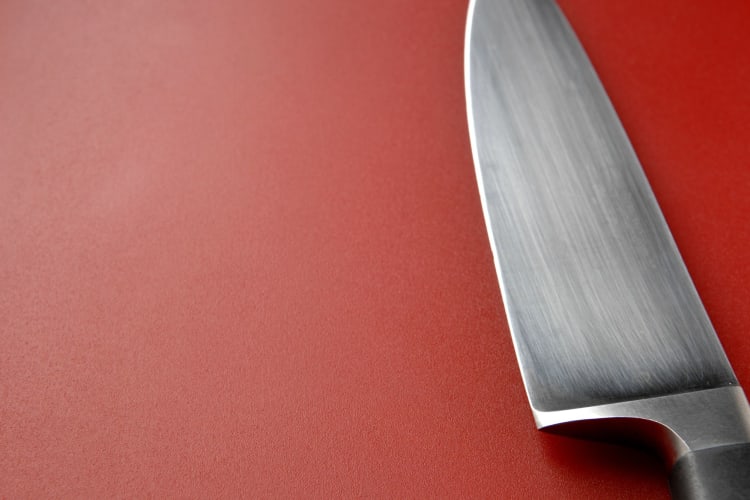
Bevel
Santokus can have a double or single bevel — the edge that’s been ground down to form a sharp blade edge — and a shorter and rounded tip. The chef’s knife usually only has a double bevel.
With a single bevel, there’s a finer angle on the cutting edge. This results in a sharper blade edge. Single bevel knives can be sharpened up to 15 degrees. A chef’s knife can have a bevel of 30 degrees on both sides, but the santoku has the sharper cutting edge. A more narrow angle results in a sharper blade, however a wider angle results in a more durable blade.
With their precision-honed blades, santoku knives can create extremely thin slices of vegetables, meat and fish. This is an essential element in traditional Japanese cuisine like sushi making, as well as slicing super thin cucumbers, carpaccio, sopressata and prosciutto for a charcuterie board. If you crave these really thin slices, a santoku is your best bet when deciding between a santoku vs. chef's knife.
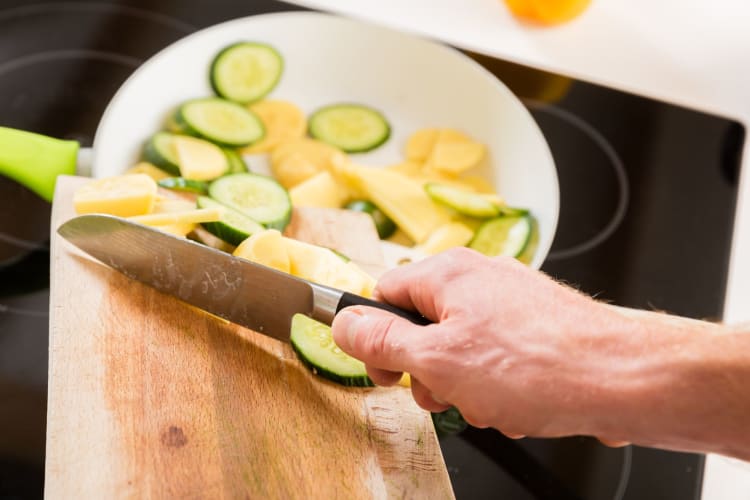
3. Size
When comparing a santoku vs. a chef's knife, you’ll find that the santoku is shorter and lighter. The santoku knife ranges in size from 5 inches to 7.9 inches and is a good choice for home chefs with small hands.
A chef’s knife has a longer blade and handle. It can be 10 to 14 inches in length. This results in the chef’s knife being heavier to hold, but the longer length allows for the slicing, disjointing and cutting of larger cuts of beef and big batches of vegetables.
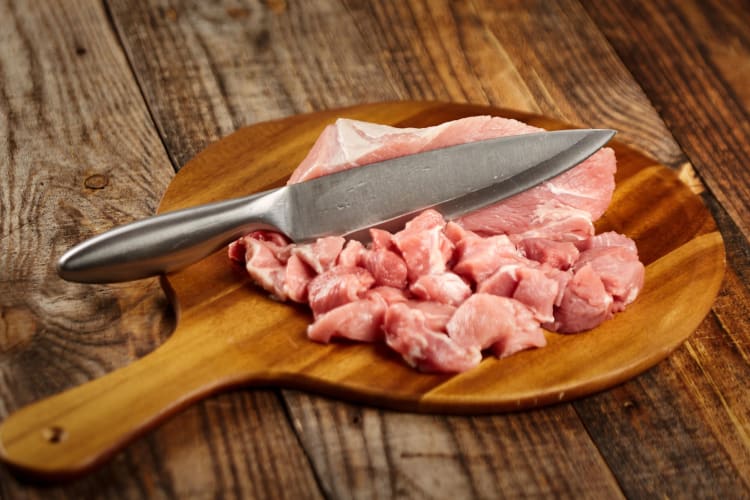
4. Materials
Santoku knives are made from harder Japanese stainless steel, which holds a cutting edge better and needs less sharpening. However, when comparing a santoku vs. chef's knife, this can make it more prone to chips and cracking.
Chef’s knives are usually made from softer metals like stainless steel, ceramic or carbon steel. This type of metal requires more sharpening but won’t break as easily.
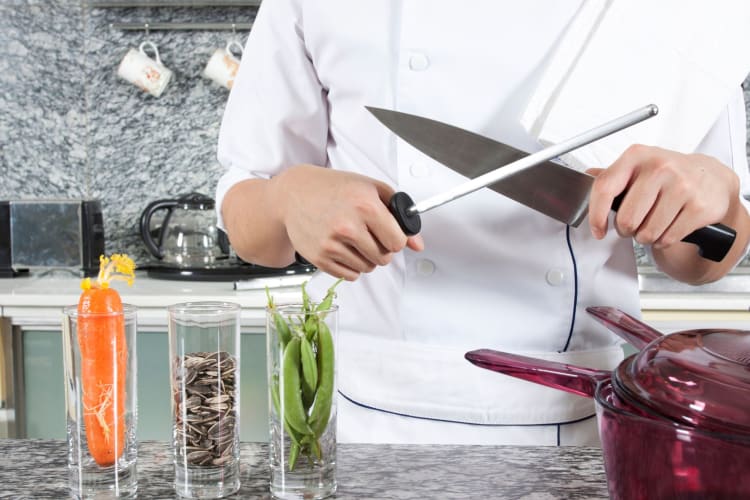
5. Cutting Technique
The shape of these blades is a major factor in the cutting techniques you’d use with a santoku vs. a chef’s knife.
Santoku knives and other Japanese knife types are designed for a single downward cut, a traditional Japanese culinary technique.
The chef’s knife is designed for the rocking cuts used for slicing through an onion (part of the knife blade stays on the cutting board), whereas a santoku is more often used for chopping (the blade is moving up and down on the board).
While you could certainly use either type of knife for many of the same cutting tasks, one might give better results than the other. Likewise, the size and shape of one might appeal more to your kitchen needs and preferences than the other.
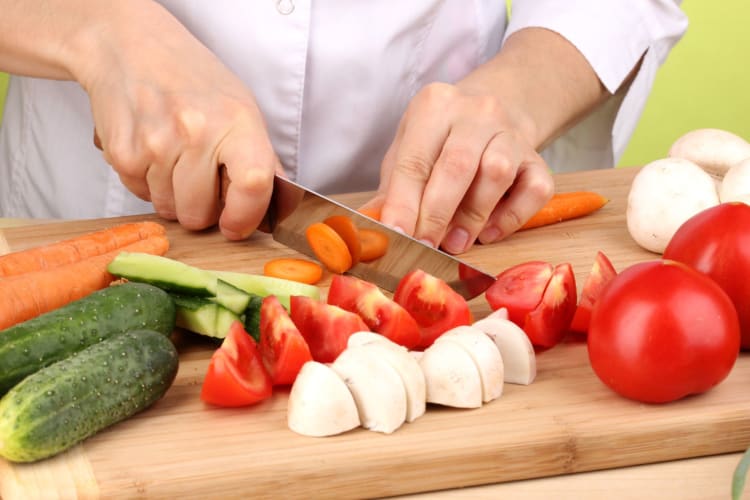
Now that you know the difference between a santoku vs. chef's knife with this knife guide, you’re ready to slice, dice and mince like a pro. The best part about learning new techniques is trying them out with top-quality kitchen tools.
For even more ways to elevate your kitchen, check out chef-recommended cutlery in the Cozymeal Shop.



FOOD FOR THOUGHT?
Join the conversation.